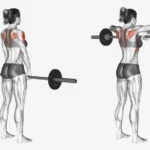Seated Calf Raise: Exercise Overview
The seated calf raise is a targeted isolation exercise designed to strengthen and develop the calf muscles, specifically the soleus, with secondary engagement of the gastrocnemius. Performed on a calf raise machine, this variation isolates the calves by minimizing involvement of other muscle groups, making it an effective choice for building lower-leg size and strength.
The calves are often a challenging muscle group to develop, so incorporating varied angles and frequent training can optimize growth (Schoenfeld, 2010). The seated calf raise is a versatile addition to leg-focused workouts, lower-body sessions, or full-body routines, supporting both aesthetic goals and functional lower-leg strength for activities like running or jumping (Wirth et al., 2016).
How to Perform the Seated Calf Raise
- Sit on a seated calf raise machine, placing the balls of your feet on the platform with toes pointing forward and heels naturally hanging off the edge.
- Position the knee pads snugly over the base of your quadriceps and rest your hands lightly on the pads or handles—this is your starting position.
- Extend your ankles to lift the weight and release the safety bar, keeping your movements controlled.
- Lower your heels by dorsiflexing your ankles, stretching your calves fully until you feel a gentle pull.
- Flex your calves to extend your ankles, raising your heels as high as possible, and pause briefly at the top to maximize contraction.
- Repeat for the desired number of repetitions.
Tips for Optimal Performance
- Control the Movement: Perform the raise and descent slowly to maximize calf engagement and avoid momentum, enhancing muscle activation and growth (Schoenfeld, 2016).
- Pause at the Top: Hold the top position for 1–2 seconds to emphasize the contraction and strengthen the mind-muscle connection.
- Push Through the Ball of the Foot: Focus on moving through the ball of your foot rather than the toes to target the calves effectively and reduce foot strain.
- Limit Heel Depth: Avoid excessive lowering if you feel discomfort or a stretch in the bottom of your foot, as this may indicate overextension (McGill, 2010).
- Experiment with Foot Position: Adjust toe angles (neutral, slightly in, or out) to find the most comfortable and effective position for your ankle mobility and calf activation (Wirth et al., 2016).
- Breathe Properly: Exhale as you raise your heels and inhale as you lower them to support controlled movement and muscle oxygenation.
Building strong calves with seated raises? See how they fit into our Ultimate Guide to Muscle Groups for leg power.






